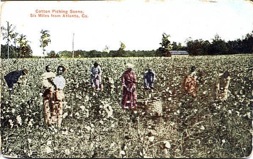





Postmaster Cobb County, Boltonville -
1867 - B. F. Moulding

Mayor -- 1870 -- Hon. J. David Collins


Moore’s Mill Road, was named for Thomas Moore (1828-1914) who operated a sashsawmill and a grist mill on Peachtree Creek above the confluence of Nancy Creek. He also served as postmaster of Boltonville.
Picking Cotton Scene
Six Miles from Atlanta Ga.

Notice that Boltonville is on the
north side of the river in Cobb County.

L & N bridge on Atlanta Road
Mr. T. G. Crusselle claims the honor of building the first house in Atlanta. He built a log cabin on the lot on which the Kimball House now stands, on the corner where the Big Bonanza is at present. The house was for the accommodation of the hands who were then grading the country around here for building railroads.
The first hotel, or even boarding house, ever erected in Atlanta, was an old two room, story and a half house, which was brought to Atlanta from Boltonville, in 1843, that Mr. Crusselle superintended. The structure was supported in an upright position upon two flat cars, a distance of six miles. The house narrowly missed toppling over into the Chattahoochee as it was being hauled across the bridge. Many of the men who helped to move the house to Atlanta, rode down from Boltonville on top of the house, and some inside of it. It was called the Gannon House, after it’s owner.
Mr. Crusselle had the contract for building the old State Road stone freight depot, which used to stand in the block in which the office of the Southern Express Company now stands, very near the present passenger depot. When Mr. Crusselle finished the depot he was jubilant, and endeavored to demonstrate that fact to the town by a grand treat. Accordingly he bought a barrel of Georgia planters corn whisky, a half a barrel of brandy and a box of Virginia tobacco, which he dealt out liberally to the citizens. He says that almost every one got drunk, the fighting became general, and some of them attempted to turn over the town, but they did not succeed.

